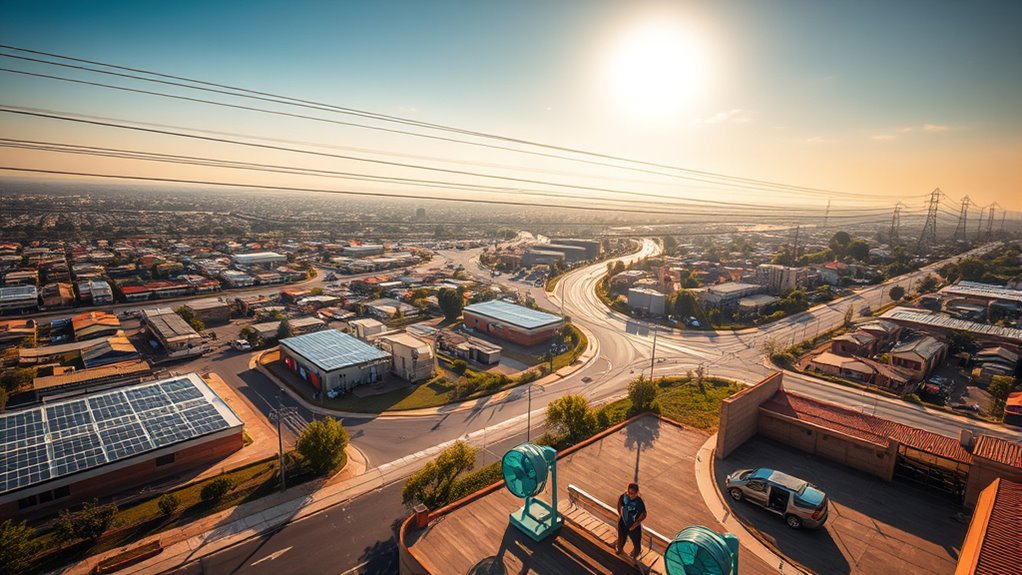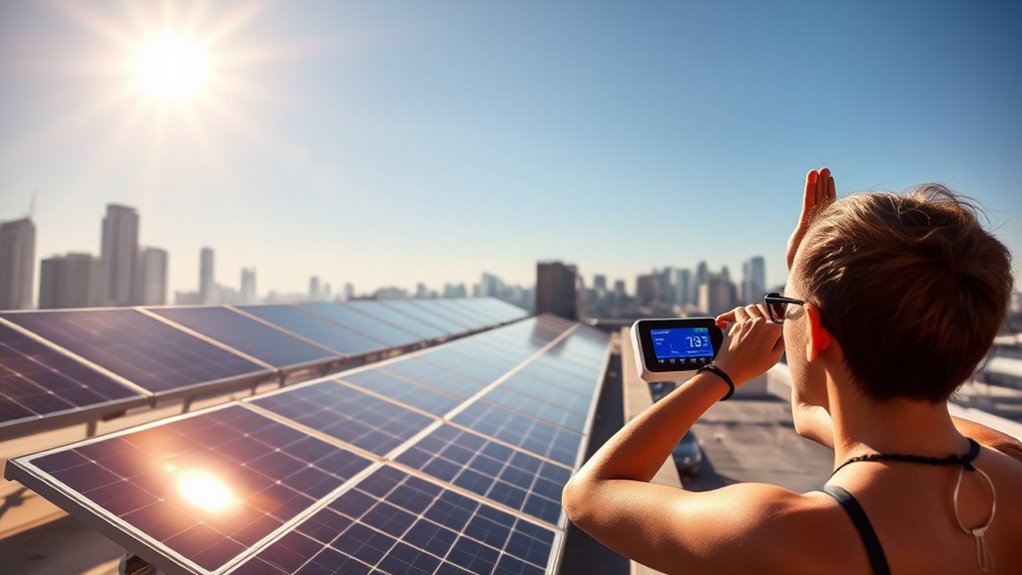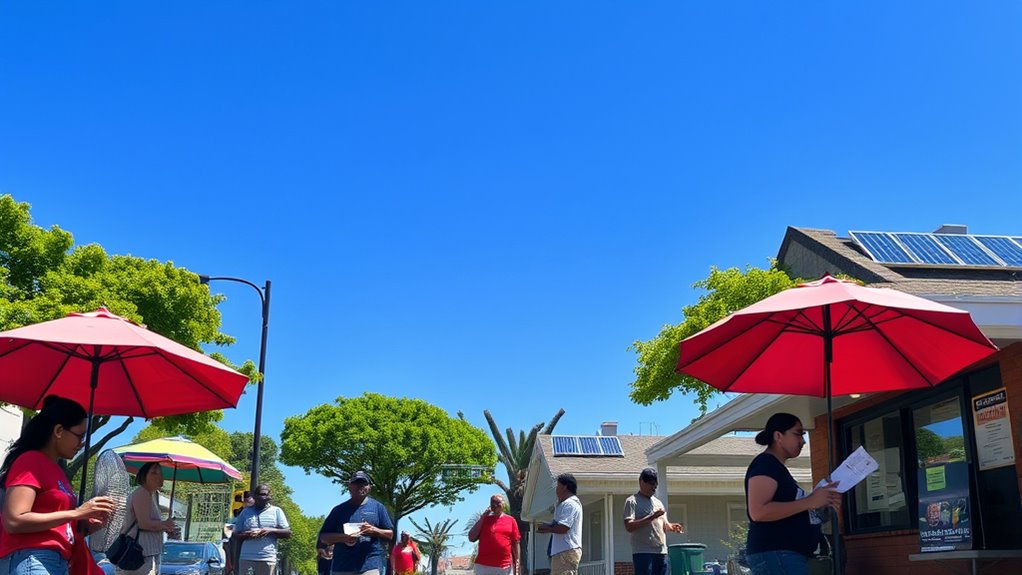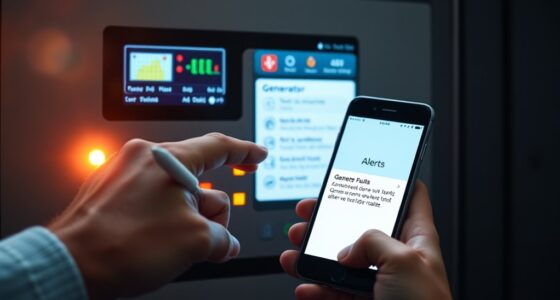To prepare for heatwaves and grid strain, stay informed about weather alerts and implement energy-saving habits like limiting air conditioning use during peak times. Invest in portable fans, ensure proper home insulation, and consider backup power options if possible. Support community programs that promote demand response and energy efficiency. Strengthen your home’s resilience and community connections to better handle emergencies. Keep exploring ways to stay protected and contribute to grid stability as conditions change.
Key Takeaways
- Implement demand response programs and automate energy use to reduce grid stress during peak heat periods.
- Upgrade infrastructure with smart grids, energy storage, and cooling centers to improve resilience against heatwaves.
- Stay informed through local heat alerts and health advisories to take timely protective measures.
- Increase community engagement and education on energy efficiency and heat adaptation strategies.
- Support policies and investments focused on renewable energy, grid modernization, and vulnerable population protections.
Understanding the Impact of Heatwaves on Energy Demand

How do heatwaves affect energy demand? During heatwaves, you’ll notice a significant jump in power usage, often up to 14% in some regions like Spain and France. Peak demand can spike sharply, with increases of 15% or more, especially in late afternoons and evenings when cooling needs are highest. In the US, demand rose by 3.3% from April to September 2024 compared to the previous year, driven by cooling requirements. These surges push grid systems to their limits, sometimes reaching record peaks like 160,560 MW in the PJM grid. As temperatures stay high longer, the stress on energy infrastructure intensifies, increasing the risk of outages and instability. The summer of 2025 saw managing this demand is vital to maintaining a reliable, resilient power supply during extreme heat events. Additionally, prolonged heatwaves can lead to increased use of air conditioning systems, further amplifying the strain on the energy grid. The rising demand for cooling also correlates with increased electricity consumption during heatwaves, highlighting the importance of energy efficiency measures to reduce grid strain. When communities adopt demand response programs, they can help balance the grid during peak periods and prevent outages. Furthermore, implementing smart grid technology can enhance the capacity to adapt to these fluctuating demands efficiently.
Enhancing Grid Resilience Through Infrastructure Investment

Investing in infrastructure is vital for strengthening the resilience of the electrical grid against the increasing frequency and severity of heatwaves. The federal government has allocated significant funding through programs like the Infrastructure Investment and Jobs Act (IIJA), which provides around $62 billion for energy infrastructure, including $14 billion specifically for grid reliability and resilience. The DOE’s Grid Resilience and Innovation Partnerships (GRIP) program administers $10.5 billion to improve grid flexibility and withstand extreme weather. Additionally, in 2024, another $4.2 billion will fund infrastructure projects aimed at fortifying the grid. These investments target upgrades to aging transmission and distribution systems, the integration of smart grid technologies, and expanding capacity to manage renewable energy variability. Public-private partnerships are essential for maximizing these funds and accelerating modernization efforts. The IIJA also emphasizes strategic deployment of funds to ensure equitable access and long-term sustainability. Developing robust grid infrastructure is crucial to effectively support these modernization initiatives and ensure reliable energy delivery during extreme conditions. Furthermore, adopting advanced grid management techniques can optimize energy distribution and improve overall system resilience.
Leveraging Demand Response and Load Flexibility Strategies

During heatwaves, utilities increasingly rely on demand response (DR) and load flexibility strategies to manage grid stress effectively. DR events surged in summer 2024, with nearly daily activations during extreme heat, helping prevent blackouts. By incentivizing customers to reduce or shift cooling loads, utilities managed over 4.5 GW of load across 116 events, enhancing grid stability. Customer participation has expanded, with programs involving tens of thousands of users, allowing for load shifting without major disruptions. Automated controls and smart thermostats enable quick, responsive adjustments, especially during peak hours. These strategies diminish reliance on costly peaker plants and lower emissions. Demand response activity increased significantly in 2024, reflecting the growing importance of flexible load management. Effective coordination between grid operators and DR providers ensures timely activation, making demand response a critical tool in maintaining grid resilience amid rising heatwave frequency and intensity. Additionally, fostering active communication between consumers and utilities can improve participation rates and optimize load management during critical periods. Moreover, integrating demand response with other grid modernization efforts can further enhance overall energy system resilience. Load flexibility also plays a vital role in adapting to the increasing frequency of heatwaves, ensuring the grid remains stable under stress. Implementing advanced load management techniques can further optimize how energy is distributed and conserved during periods of high demand.
Integrating Renewable Energy and Storage Solutions Effectively

Integrating renewable energy and storage solutions effectively is vital for building a resilient and sustainable power grid. As renewable sources like wind and solar become a larger part of the energy mix—projected to reach 45-50% globally by 2030—you’ll face challenges like network capacity limits and instability risks such as voltage fluctuations and frequency issues. Modernizing grid infrastructure with grid-enhancing technologies (GETs) and expanding transmission capacity are key steps. Utility-scale batteries help manage the intermittent nature of renewables by storing excess power for later use, supporting grid stability during peak demand. Additionally, best oils for deep frying on keto diet and implementing precise short-term forecasting and dynamic pricing incentivize ideal energy use, ensuring renewables integrate smoothly. Moreover, implementing grid stability measures is essential to mitigate fluctuations and maintain reliable power delivery. Developing advanced cybersecurity protocols is also crucial to protect the grid infrastructure against cyber threats, especially as digital control systems become more prevalent. Incorporating hydrogen energy technologies can further enhance grid resilience by providing a clean energy storage option and supporting decarbonization efforts. Together, these strategies help you create a flexible, reliable grid capable of handling increased renewable penetration and heatwave-related stresses.
Planning for Future Heatwaves: Policies and Community Actions

As renewable energy sources become more integrated into the power grid, planning for the increasing frequency and severity of heatwaves becomes critical. Governments must implement heat action plans that include early warning systems, healthcare capacity building, and public education. Tailoring policies to local conditions and engaging communities ensures better uptake, especially in resource-limited areas. Establish outreach programs for high-risk groups like the elderly and chronically ill, and foster multi-stakeholder collaborations involving health officials, community organizations, and advocacy groups. Infrastructure adaptations, such as cooling centers, green spaces, and reflective surfaces, help mitigate heat risks. These combined efforts enhance resilience, reduce heat-related mortality, and ensure quicker responses to future heatwaves. Recognizing the importance of climate adaptation strategies can further strengthen community resilience and preparedness. Additionally, incorporating community engagement techniques can foster greater awareness and proactive participation among residents to better withstand heat-related challenges. Emphasizing the role of predictive analytics for small business can also aid in optimizing resource allocation and emergency response planning during heat events.
Frequently Asked Questions
How Can Individual Consumers Reduce Their Energy Use During Heatwaves?
You can reduce your energy use during heatwaves by setting your thermostat to 78°F or higher and using smart controls to optimize cooling. Limit the use of major appliances like ovens and dryers during peak hours, unplug devices when not in use, and switch to energy-efficient appliances. Using ceiling fans and sealing leaks around doors and windows also help keep your home cooler and lessen grid strain.
What Are the Best Ways to Upgrade Aging Power Infrastructure Quickly?
You can’t build Rome in a day, but you can speed up upgrading aging power infrastructure by prioritizing replacements and upgrades over new construction. Invest in high-capacity conductors, modern transformers, and underground lines to reduce outages and improve resilience. Deploy smart grid tech like real-time monitoring and automated fault systems, and expand energy storage and microgrids for flexibility. Partner with industry experts and secure large investments to accelerate the process effectively.
How Do Energy Tariffs Influence Consumer Behavior During Peak Demand?
Energy tariffs directly influence your behavior during peak demand by incentivizing you to shift usage to off-peak times through higher prices during peaks and lower prices off-peak. When the price ratio increases, you’re more likely to reduce consumption during busy periods, especially with automation tools like programmable thermostats. Clear communication and automation make it easier for you to respond, helping you save money while easing grid strain and enhancing overall system stability.
What Role Do Regional Collaborations Play in Managing Heatwave Grid Stress?
Regional collaborations play a vital role in managing grid stress during heatwaves. You benefit from well-connected transmission networks that enable sharing electricity across regions, reducing blackout risks. These partnerships coordinate response strategies, activate demand response programs, and facilitate resource sharing through interregional lines. By working together, you get a more reliable, resilient grid that can handle extreme heat, ensuring consistent power supply and lowering overall stress on the system.
How Can Emerging Technologies Improve Grid Reliability in Future Heatwaves?
Emerging technologies can boost your grid’s reliability during future heatwaves by using AI and advanced analytics to predict demand spikes and identify issues early. Battery energy storage systems help balance supply and demand, while smart grid management optimizes energy flow. Demand response programs and virtual power plants give you flexible options to reduce load. These innovations work together to make certain your power stays stable when heat stress peaks.
Conclusion
To stay prepared, you must understand the risks, invest in resilient infrastructure, embrace demand flexibility, and support renewable solutions. You should plan ahead, advocate for smart policies, and engage your community. By doing so, you’ll strengthen your response, reduce grid strain, and protect your environment. Preparing for heatwaves isn’t just about reacting—it’s about acting, adapting, and advancing. Together, you can create a resilient future that withstands the heat and powers on.










